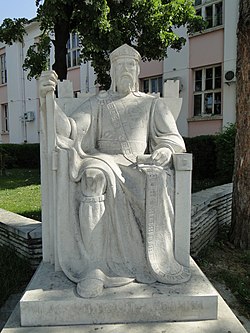
Back Simeón I de Bulgaria AN سيميون الأول ملك بلغاريا Arabic سيميون الاول ملك بلجاريا ARZ Simeón I de Bulgaria AST I Simeon AZ بؤیوک سیمئون AZB Сімяон I BE Симеон I Bulgarian Simeon I BS Simeó I el Gran Catalan
| Simeon the Great Симеон І Велики | |
|---|---|
 Statue of Simeon I in Vidin | |
| Emperor of the Bulgarians and Romans | |
| Reign | 893 – 27 May 927 |
| Predecessor | Vladimir |
| Successor | Peter I |
| Born | 864/865 |
| Died | 27 May 927 (aged 62 or 63) Preslav, Bulgarian Empire |
| Spouses | Unknown name (first spouse) Maria Sursuvul |
| Issue | Michael Peter, Emperor of Bulgaria Ivan Rilski Benjamin |
| Dynasty | Krum's dynasty |
| Father | Boris I |
| Mother | Maria |
Tsar Simeon (also Symeon)[1] I the Great (Church Slavonic: цѣсар҄ь Сѷмеѡ́нъ А҃ Вели́къ; Bulgarian: цар Симеон I Велики, romanized: Simeon I Veliki[2] [simɛˈɔn ˈpɤrvi vɛˈliki]; Greek: Συμεών Αʹ ὁ Μέγας, romanized: Sumeṓn prôtos ho Mégas) ruled over Bulgaria from 893 to 927,[3] during the First Bulgarian Empire. Simeon's successful campaigns against the Byzantines, Magyars and Serbs led Bulgaria to its greatest territorial expansion ever,[4] making it the most powerful state in contemporary Eastern and Southeast Europe.[5] His reign was also a period of unmatched cultural prosperity and enlightenment later deemed the Golden Age of Bulgarian culture.[6]
During Simeon's rule, Bulgaria spread over a territory between the Aegean, the Adriatic and the Black seas.[7][8] The newly independent Bulgarian Orthodox Church became the first new patriarchate besides the Pentarchy, and Bulgarian Glagolitic and Cyrillic translations of Christian texts spread all over the Slavic world of the time.[9] It was at the Preslav Literary School in the 890s that the Cyrillic alphabet was developed.[10][11][12] Halfway through his reign, Simeon assumed the title of "emperor" (Tsar),[13] having prior to that been styled "prince" (Knyaz).[14]
- ^ For example, in Fine, The Early Medieval Balkans.
- ^ This article uses the United Nations-authorized scientific transliteration system to romanize Bulgarian Cyrillic. For details, see Romanization of Bulgarian.
- ^ Lalkov, Rulers of Bulgaria, pp. 23–25.
- ^ Enciklopedija Bǎlgarija (in Bulgarian). Akademično izdatelstvo "Marin Drinov". 1988. OCLC 75865504.
- ^ The First Bulgarian Empire. Encarta. Archived from the original on 4 December 2007. Retrieved 3 March 2007.
- ^ Hart, Nancy. Bulgarian Art and Culture: Historical and Contemporary Perspectives (PDF). University of Texas at Austin. p. 21. Archived from the original (PDF) on 10 August 2007. Retrieved 3 March 2007.
- ^ Weigand, Gustav (1924). "1 Istoriko-geografski obzor: 4 Srednovekovie". Etnografija na Makedonija (in Bulgarian). trans. Elena Pipiševa. Leipzig: Friedrich Brandstetter. Archived from the original on 15 April 2007.
- ^ Bakalov, Istorija na Bǎlgarija, "Simeon I Veliki".
- ^ Castellan, Georges (1999). Istorija na Balkanite XIV–XX vek (in Bulgarian). trans. Liljana Caneva. Plovdiv: Hermes. p. 37. ISBN 954-459-901-0.
- ^ Dvornik, Francis (1956). The Slavs: Their Early History and Civilization. Boston: American Academy of Arts and Sciences. p. 179.
The Psalter and the Book of Prophets were adapted or "modernized" with special regard to their use in Bulgarian churches, and it was in this school that glagolitic writing was replaced by the so-called Cyrillic writing, which was more akin to the Greek uncial, simplified matters considerably and is still used by the Orthodox Slavs.
- ^ Southeastern Europe in the Middle Ages, 500–1250, Cambridge Medieval Textbooks, Florin Curta, Cambridge University Press, 2006, pp. 221–222., ISBN 0521815398
- ^ The Orthodox Church in the Byzantine Empire, Oxford History of the Christian Church, J. M. Hussey, Andrew Louth, Oxford University Press, 2010, p. 100., ISBN 0191614882
- ^ "Цѣсарь Блъгарѡмъ". Zlatarski, Istorija na Pǎrvoto bǎlgarsko carstvo, p. 367.
- ^ Zlatarski, Istorija na Pǎrvoto bǎlgarsko carstvo, p. 280.